Ruined Rome -- The "eternal city" (12/07/03)
Last updated 12/22/03
Senators in togas, Julius Caesar, the Pope
tooting around in the PopeMobile (TM) and Russel Crowe as "the
gladiator" are just some of the images that Rome invokes in
my mind. The city, once home to two great empires - the Holy Roman
Empire and the Catholic Church, manages to combine ruins which are a
couple of millenia old with a bustling metropolis at the forefront of
the European Union. Although I prefer the bricks in Siena and the
canals of Venice to the ruins of Rome, I appreciate its significance to
Western Civilization and I sensed its majestic past as I wandered
the streets.
While the origins of Rome may be traced back to Etruscan, Latin and
Sabine settlements in the region, the legend of Romulus and Remus must
be popular among Italians because they have raised
raised statues of a she-wolf nursing two babies throughout their
cities. The story goes that
the twins were raised by a she-wolf and that Romulus killed his brother
and then established the city of Rome. The little I know of this legend
already makes it more fascinating than the idea of another city founded
due to fertile soil and a prime location near a river (the Tiber) --
I'll take humans with wolves' blood
killing each other and then founding an empire any day.
Now you must be wondering, what do you do when in Rome? The answer is
obvious: you do as the Romans do! But seriously, there's a lot to do in
this place, and it generally centers around looking at a lot of old
stuff, religious stuff, or old religious stuff. First off I'll go
through some of the "old stuff" you can see next time you happen to be
passing through Rome and have some time to kill...
When it comes to old, you can't get much older than the Roman Forum --
all that's left is a couple of columns and a few walls, which are
simply there to tell you that you're in a place that is OLD (actually
there is a bit more there, but I'll get to that shortly). The Forum,
once the commercial, political and religious center of ancient Rome,
still plays a central role in the city -- at least geographically (it's
actually pretty much in the middle of a map of Rome). The area was once
a major site of political rallies, public ceremonies and senate
meetings, and with a little imagination you'll find yourself amidst the
grandeur of ancient Rome. The ruins were excavated during the 18th and
19th centuries and contain several interesting sites: the Arco di
Settimo Severo, erected in 203AD to honor emperor Settimo is considered
one of Italy's major triumphal arches (I suppose there was a time when
countries were big on such things: Arc de Triomphe and India Gate come
to mind). The ruins also include the Templo di Giulio Cesare (Temple of
Julius Caesar) where Mark Anthony read his famous speech. One thing you
discover after walking among ruins for a couple of minutes: they all
look the same. If you've seen a tiny portion of a wall, or a broken
column, seeing the same sight played out throughout a region gets
boring real fast.
For something a bit newer, how about the Colosseum, originally known as
the Flavian Amphitheatre, which dates from 72 AD. It's in much better
shape than the Forum due to reconstruction efforts (seems like cheating
to do this to me, but I guess you gotta protect your cash cows). The
area was the site of bloody gladiatorial (is that even a word?) combat
to the delight of 80,000 screaming fans, and nowadays you can still
find gladiators outside the Colosseum, though the only thing they do is
pose for pictures. The ruins of the arena are complicated by the fact
that it was used as a fortress during the Middle Ages, and also as a
quarry for travertine and marble. So if you find yourself scratching
your head wondering what use underground passages might have in such a
structure remember that it had multiple uses (not simultaneously of
course) which resulted in various architectural changes, and you're
just seeing the odd leftovers...
When you're done looking at all that old stuff, you can soak in
religion at the some of the local churches.While St. Peter's basilica
in the Vatican is probably the most famous
and most visited church in Rome (perhaps the world), the city which is
the heart
of Catholicism offers many other impressive churches for the interested
visitor. The 5th century Santa Maria Maggiore has an impressive baroque
facade and a nativity scene with a crib that dates from
the 13th century. The oldest Christian basilica in Rome (4th century)
was rebuilt in the 17th century into the Basilica di San Giovanni in
Laterano, which has an impressive set of statues on the rooftop
consisting of Jesus and the apostles. This cathedral was the primary
church in Rome before the construction of St. Peter's basilica. Most
Romans would make a 5km trek to San Giovanni from the Vatican after
receiving a blessing from the pope.The most "fun" church has to be
Santa Maria in Cosmedin, which, apart from being one of the finest
medieval churches in Rome and having a beautiful floor of Cosmatesque
inlaid marble, also has the Bocca della
Veritá (Mouth of Truth). Supposedly if you put your right
hand
into the
mouth and tell a lie, it will snap shut. I joined other tourists in
taking pictures with our hands in the mouth, but I was smart enough to
keep my mouth shut at the time.
Vatican City, the smallest country in the world due to the Lateran
treaty signed by Musollini in 1929, is fairly self sufficient. It has
its own postal service (including stamps which are only valid for mail
originating from the Vatican), train station, and army of Swiss guards.
There is also intense security with X-ray machines and metal detectors,
so you really feel like you're going to a new country (or at least
entering the airport at one). Despite its impressiveness (and St
Peter's is pretty impressive -- in larger than life kind
of way), I didn't really get much of a holy feeling while visiting the
cathedral. It had the atmosphere of a tourist attraction rather than a
church. I think that other visitors had this feeling as well, for there
were many situations which seemed to confirm this: large groups of
people moving through the church talking loudly and pointing at the
"marvles", some recording it all with their camcorders while providing
a monologue for the entire experience, and yet others who stopped to
pose for pictures with the alter or the multi-lingual confessionals. We
even saw a little baggage
tram with several carts in tow go right through the church. These
sights combined with the colossal size of the church (it really felt
like a Costco, and not a place of religious service) left me with an
odd, not-quite-right feeling about the most famous of churches. Still,
as with most things on this trip, it was something worth experiencing
for myself.
Pictures
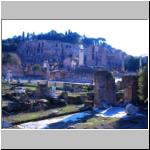
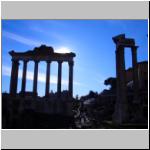
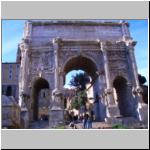

This is the most common sight in Rome -- RUINS. The Roman Forum used to
be a commercial, political and religious center of ancient Rome and was
the place where the Senate gathered. Now its the place where groups of
guided tourists gather to play amateur archeologist.
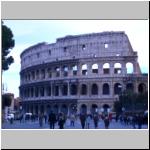
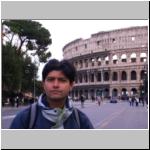
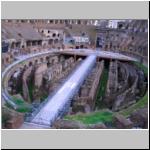
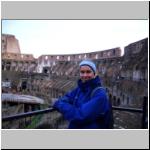
The Roman Colosseum, site of bloody gladiator combat which spawned a
recent Hollywood flick, is the most famous monument in Rome (you can
buy tons of tourist kitsch involving this thing). It's almost 2000
years old, being constructed in 72AD, and would've completely fallen
apart by now if not for all the reconstruction efforts (can't let the
cash cow die you know).
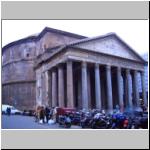
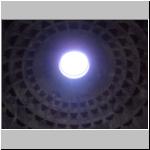
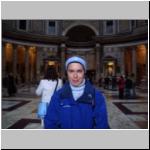
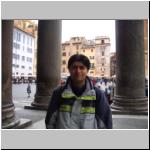
The Pantheon is the best preserved building of ancient Rome due to its
conversion from a temple dedicated to Roman gods into a Christian
church.

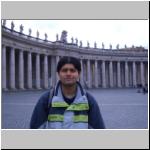
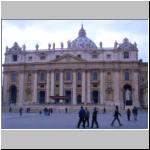
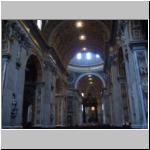
Vatican City = the smallest country in the world (thanks to Mussolini).
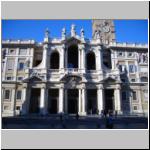
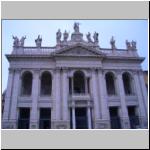
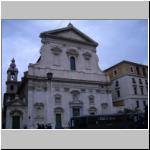
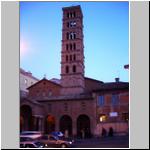
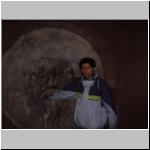
Rome is chock-full of churches of all sorts (Catholic/Christian
mostly). Nearly every church keeps a treasure of some sort (eg: mosiacs
on the floor, chains of St. Peters, piece of Jesus's original baby
crib, gigantic statues on the roof, or "the mouth of truth" which
clamps down on your hand if you tell a lie). I stuck my hand inside the
mouth of truth, but wisely kept my own mouth shut during the picture.

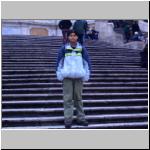
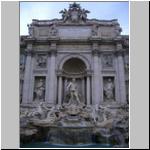
The touristy things to do in Rome -- get your portrait painted by a
local artist on the Spanish Steps, and throw TWO coins into Fontana di
Trevi (the first one doesn't grant you a wish, only your return to
Rome).

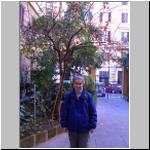

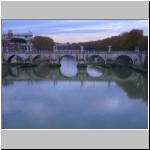
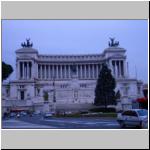
Some random sights from Rome, including a tiny car (Smart Car) --
typical European-sized car, the courtyard of our hostel (Lilliput
Hostel), Circus Maximus - where chariot races took place, the San
Angelo bridge over the Tiber river that snakes through Rome, and a
beautiful palace which now of course happens to be a museum.




























